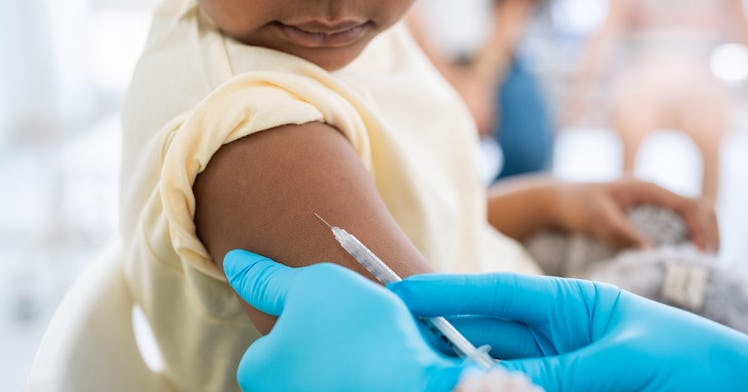Everything Parents Need to Know About the DTaP and Tdap Vaccines
The vaccines are for different age groups, and parents need one of them too.

Diphtheria, tetanus, and pertussis: three deadly diseases that can cause symptoms as varied as violent coughing and seizures. Altogether, these illnesses used to kill thousands of young kids each year. In the early to mid 1900s, yearly outbreaks of around 200,000 cases of
diphtheria and pertussis were normal. On a smaller scale, tetanus sickened around 500 Americans annually in the late 1940s. But now, very few children come down with these illnesses as a result of the DTaP and Tdap vaccines. Tetanus, pertussis, and diphtheria are all bacterial infections. Tetanus, also known as lockjaw, causes muscles to painfully seize up; diphtheria is a serious infection of the nose and throat that can can cause fatal heart and nerve damage; and pertussis, commonly known as whooping cough, causes violent, uncontrollable fits of coughing that can make it difficult to breathe.The vaccines that prevent these diseases have gone through many iterations over the decades since they were invented and have helped drastically reduce the number of cases. There were only two cases of diphtheria in the U.S. between 2004 and 2017. And there are only about 30 cases of tetanus each year. Pertussis is a slightly different story. Vaccination campaigns were so successful in the mid-1990s that cases of whooping cough plummeted to just over 1,200 per year, nearly eradicating the disease. But that didn’t last long. Since then, cases have steadily increased, peaking at nearly 50,000 in 2012 before beginning to decline again, yet remaining higher than expected. New research indicates that the newest vaccines allow asymptomatic cases of pertussis. Other data suggests it’s because there aren’t enough people getting vaccinated and because immunity declines over time — which is why it’s important to stay up-to-date on your shots.
Tdap vs. DTap: The Difference Between the Vaccines
Whether your child should get the DTaP or Tdap vaccine depends on their age. DTaP is a vaccine for children under the age of 7, while Tdap is a booster for anyone 7 years and older. Tdap has lower doses of diphtheria and pertussis in it because it’s meant to boost immunity from previous DTaP shots.Children should receive their first three DTaP vaccinations at 2 months, 4 months, and 6 months of age. Their fourth dose of the vaccine should come when they’re between 15 and 18 months old, with the fifth dose due a few years later between the ages of 4 and 6. Once a child reaches middle school, their pediatrician will recommend their first Tdap vaccine at age 11 or 12. Kids aren’t the only ones who need to get vaccinated against diphtheria, pertussis, and tetanus. Adults should get a Tdap booster shot every 10 years. They may need a booster sooner if they get a severe cut or burn that gets dirty, if it’s been at least five years since their last shot. Pregnant people also need to get vaccinated during their third trimester to pass on antibodies to their baby, keeping them protected in their first few months of life before they’re eligible for the vaccine.
DTaP and Tdap Efficacy
Both the DTaP and Tdap vaccines are highly effective. According to the Centers for Disease Control and Prevention (CDC), DTaP prevents up to 80% to 90% of vaccinated children from getting sick, while Tdap protects around 70% of adolescents and adults in the year after they get their shot. Vaccinated people who do become sick are less likely to have severe disease.Immunity wanes after several years, so it’s important for kids and adults to get their DTaP or Tdap vaccines on time.
Tdap and DTaP Vaccine Side Effects
The side effects for DTaP and Tdap vaccination are usually mild. They include:
- Swelling, achiness, or redness at the injection site
- Tiredness
- Mild fever
- Vomiting
The DTaP vaccine may also cause fussiness and loss of appetite. Rare but serious side effects include a fever higher than 105 degrees Fahrenheit, crying for longer than three hours straight, or excessive swelling of the arm or leg that received the injection. Discuss these and any other worrying symptoms with your child’s pediatrician.
Some people who receive a Tdap vaccine report diarrhea, nausea, and headaches. People who experience dizziness, changes in their vision, or ringing in their ears after a Tdap shot should tell their doctor. There’s a risk for an allergic reaction with any vaccine, although reactions are generally rare. If you have one, you’ll need immediate medical intervention, which is why your doctor will monitor you for around 15 minutes after administering your vaccine.
Tdap and DTaP Vaccine Ingredients
The DTaP and Tdap vaccines are inactivated vaccines, meaning they don’t contain any live bacteria. Instead, they contain dead versions of the toxins that the disease-causing bacteria produce so the body can produce antibodies against them. Depending on the brand and manufacturer, DTaP vaccines may also include an inactivated dose of polio or hepatitis B.The vaccines also include small amounts of aluminum, formaldehyde, the antibiotic neomycin, and other components. Some of these compounds help enhance the immune system’s response to the vaccine, protect the active ingredients, or prevent germs from contaminating them. The amount of aluminum a baby consumes through breast milk in the first six months of life is
20 times the amount in a single DTaP vaccine. The amount of formaldehyde in the vaccine is also safe — babies naturally produce more than 1,500 times the amount of formaldehyde in any vaccine. Rigorous testing proves that these ingredients are safe for people of all ages, unless they have an allergy to a specific ingredient.
This article was originally published on